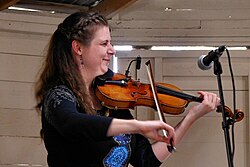
A fiddle is a bowed string musical instrument, most often a violin. It is a colloquial term for the violin, used by players in all genres, including classical music. Although in many cases violins and fiddles are essentially synonymous, the style of the music played may determine specific construction differences between fiddles and classical violins. For example, fiddles may optionally be set up with a bridge with a flatter arch to reduce the range of bow-arm motion needed for techniques such as the double shuffle, a form of bariolage involving rapid alternation between pairs of adjacent strings. To produce a "brighter" tone than the deep tones of gut or synthetic core strings, fiddlers often use steel strings. The fiddle is part of many traditional (folk) styles, which are typically aural traditions—taught "by ear" rather than via written music.
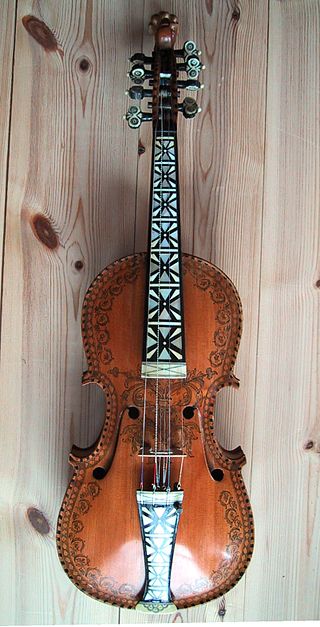
A Hardanger fiddle is a traditional stringed instrument considered to be the national instrument of Norway. In modern designs, this type of fiddle is very similar to the violin, though with eight or nine strings and thinner wood. The earliest known example of the hardingfele is from 1651, made by Ole Jonsen Jaastad in Hardanger, Norway. Originally, the instrument had a rounder, narrower body. Around the year 1850, the modern layout with a body much like the violin became the norm.

Old-time music is a genre of North American folk music. It developed along with various North American folk dances, such as square dancing, clogging, and buck dancing. It is played on acoustic instruments, generally centering on a combination of fiddle and plucked string instruments, most often the banjo, guitar, and mandolin. Together, they form an ensemble called the string band, which has historically been the most common configuration to play old-time music. The genre is considered a precursor to modern country music.
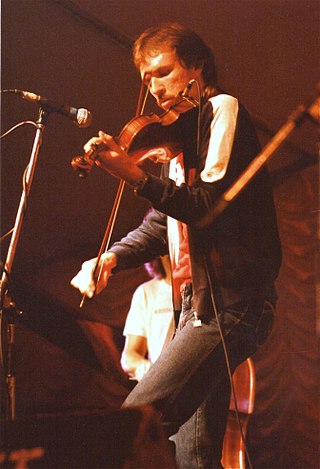
Mark O'Connor is an American fiddle player, composer, guitarist, and mandolinist whose music combines bluegrass, country, jazz and classical. A three-time Grammy Award winner, he has won six Country Music Association Musician Of The Year awards and was a member of three influential musical ensembles: the David Grisman Quintet, The Dregs, and Strength in Numbers.

Cape Breton fiddling is a regional violin style which falls within the Celtic music idiom. The more predominant style in Cape Breton Island's fiddle music was brought to North America by Scottish immigrants during the Highland Clearances. These Scottish immigrants were primarily from Gaelic-speaking regions in the Scottish Highlands and the Outer Hebrides. Although fiddling has changed considerably since this time in Scotland, it is widely held that the tradition of Scottish fiddle music has been better preserved in Cape Breton. While there is a similar tradition from the Irish-style fiddling, that style is largely overlooked as a result of the strong Scottish presence in the area.
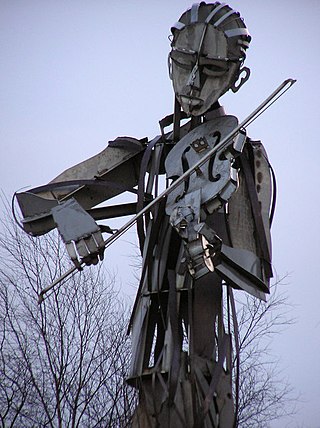
The fiddle is one of the most important instruments in the traditional repertoire of Irish traditional music. The fiddle itself is identical to the violin, however it is played differently in widely varying regional styles. In the era of sound recording some regional styles have been transmitted more widely while others have become more uncommon.
Scottish fiddling may be distinguished from other folk fiddling styles by its particular precision of execution and energy in the delivery, for example, the rendering of the dotted-quaver/semi-quaver rhythmic patterns, commonly used in the Strathspey. Christine Martin, in her Traditional Scottish Fiddling players guide, discusses the techniques of "hack bowing", "the Scotch snap", and "snap bowing". These techniques contrast quite sharply with the most common bowing patterns of Irish fiddling. The style has a very large repertoire consisting of a great variation of rhythms and key signatures. There is also a strong link to the playing of traditional Scottish bagpipes which is better known throughout the world.
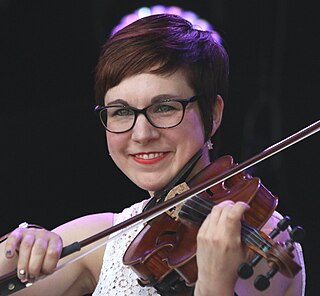
April Verch is a Canadian fiddler, singer, and step dancer raised in the community of Rankin, Ontario, located approximately 15 kilometres (9.3 mi) southwest from Pembroke, Ontario. The youngest daughter of Ralph and Muriel Verch, April began step dancing at age three with her first step dance teachers, Buster and Pauline Brown, and began learning fiddle at age six from Pembroke fiddler Rob Dagenais, shortly after receiving her first violin as a birthday present. Throughout her childhood, April played both old time fiddle and classical violin, having competed and having won awards at fiddle contests inside and outside Ontario, as well as regularly performing with the Deep River Symphony Orchestra over that period. She also competed and won numerous awards for her step dancing in that time frame as well.
Hugh Alexander “Sandy” MacIntyre (1935–2021) was one of the most respected artists in the tradition of Cape Breton fiddle music.
Julie Lyonn Lieberman is an American improvising violinist, vocalist, composer, author, educator, and recording artist specializing in fiddle and international violin styles. She is among the first to teach improvisation and world music at the Juilliard School. She also created the first eclectic styles teacher training program in the world as artistic director for the summer program, Strings Without Boundaries. Ms. Lieberman is an author, composer, producer, and performing artist.
The Glenfiddich Piping and Fiddle Championships are musical competitions for the bagpipes and fiddle. Both competitions take place annually in late autumn, at the ballroom of Blair Castle at Blair Atholl in Perthshire, Scotland. Entry to each championship is by invitation only, to those who have won various recognised major UK solo competitions held throughout the year.
Sedra Bistodeau is an American fiddler and violinist from Princeton, Minnesota.

American fiddle-playing began with the early European settlers, who found that the small viol family of instruments were more portable and rugged than other instruments of the period. According to Ron Yule, "John Utie, a 1620 immigrant, settled in the North and is credited as being the first known fiddler on American soil". Early influences were Irish, Scottish, and English fiddle styles, as well as the more upper-class traditions of classical violin playing. Popular tunes included "Soldier's Joy", for which Robert Burns wrote lyrics, and other tunes such as "Flowers of Edinburgh" and "Tamlin," which have both been claimed by both Scottish and Irish lineages.

Canadian fiddle is the aggregate body of tunes, styles and musicians engaging the traditional folk music of Canada on the fiddle. It is an integral extension of the Anglo-Celtic and Québécois French folk music tradition but has distinct features found only in the Western hemisphere.
Jeremy David Kittel is an American musician and composer. His primary instruments are the violin / fiddle and viola and his styles include Celtic, Jazz, Classical, Bluegrass, Folk music, and more.

Aidan O'Rourke is a Scottish contemporary folk music fiddle player and composer. He was named the 2014 BBC Radio 2 Folk Awards Musician of the Year and the Scots Trad Music Awards 2011 Composer of the Year. In addition to his solo career, O'Rourke also plays in the award-winning folk trio Lau alongside Kris Drever and Martin Green. He was one of 20 musicians commissioned for New Music 20x12 by PRS for Music Foundation to celebrate the 2012 Summer Olympics. O'Rourke has worked with Eddi Reader, Andy Sheppard, Alyth, Roddy Woomble and appears on more than eighty recordings. Previously, he was a member of Blazin' Fiddles, The Unusual Suspects and Tabache.
Shane Ken Cook is a Canadian violinist. He is a long-time member of the celtic fusion ensemble Bowfire, and is a past Canadian Grand Master fiddler and U.S. National Fiddle Champion. His musical career has taken him to tour across Canada, the United States, Mexico, Germany, England, China and Taiwan.
Patti Kusturok (Lamoureux) ( KUS-tə-rok) is a Canadian fiddler, performer, teacher, and composer who is known as "Canada's old-time fiddling sweetheart." She resides in Winnipeg, Manitoba where she teaches fiddling. She performs frequently in addition to teaching at workshops and music camps each summer. She has taught at the Emma Lake Fiddle Camp, Shivering Strings Fiddle Camp in Winnipeg, and Falcon Lake Fiddle Camp. Her son, Alex Kusturok is also a champion fiddler.
Billy Contreras is an American jazz violinist and bluegrass fiddler, multi-instrumentalist, session player and educator.
The Maritime Fiddle Festival is the longest running old-time fiddle contest in Canada.
